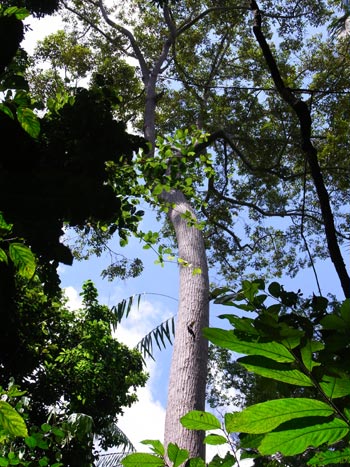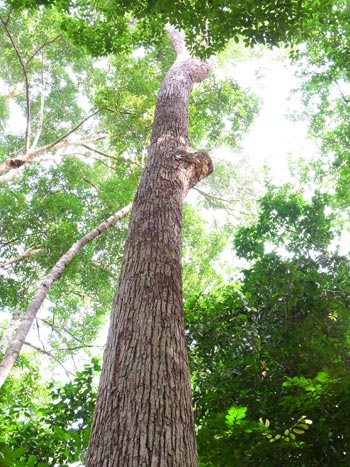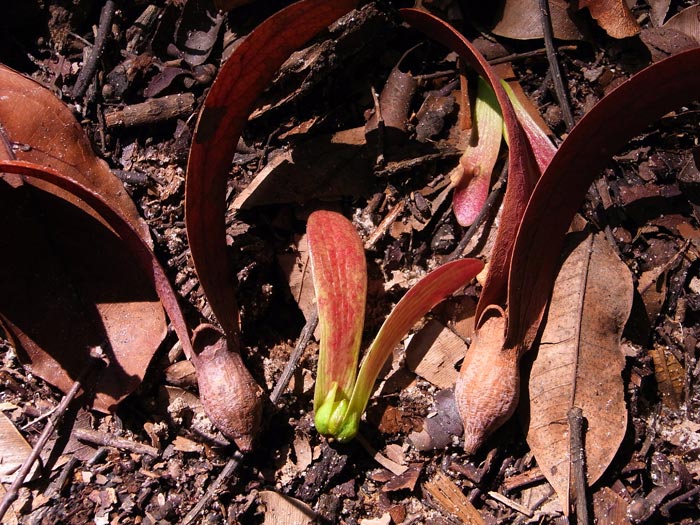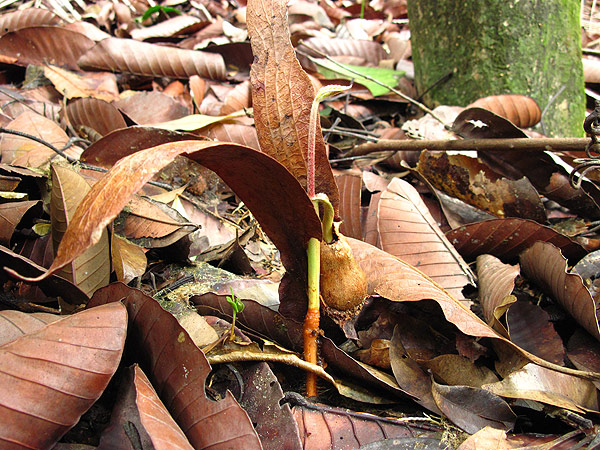The dipterocarps are a family of hardwood, tropical trees comprising about 500 species, with about 300 species (if I’m not mistaken) located on the island of Borneo. Borneo is their center of gravity, followed by Peninsular Malaysia, South Thailand, and then Sumatra – basically the evergreen tropical rainforests of the Sunda region is where they thrive. There are many genera, like Shorea, Dipterocarpus, Anisoptera, Dryobalanops, Parashorea, Vatica, Hopea, Cotylelobium, and Neobalanocarpus, with Malay names like Meranti, Balau, Kapur, Chengal, and Keruing, among others.
Dipterocarps “can” grow very tall and large, and they form a very large proportion of the rainforest canopy here in Peninsular Malaysia. An extensive study showed that up to 57% of the emergent layer of the lowland forest in Peninsular Malaysia is composed of diperocarps. In Sarawak, dipterocarps comprise even more of the emergent and canopy layer, at 75%, while in Sabah, it can be as high as 90%. Little wonder then, that Sabah has the tallest dipterocarps ever found to date; in fact Sabah has the tallest tropical trees in the world!
The current tallest tropical tree in the world is a Shorea faguetiana in Danum Valley, Sabah, which was taped drop measured at 100.8 meters tall. This astounding find surpasses all the previous records and dispels previous notions scientists had of tropical tree height. In fact this tree which has been named as “Menara” (Malay for “Tower”) is the second tallest tree (so far found) in the entire world!
In central and east Sabah, are found many other dipterocarps that are over 80 m tall! So it is likely, that many dipterocarp species are able to attain great height or size, but due to soil conditions and local weather patterns, do not achieve such dimensions. [Edit: scientists have recently found 50 trees in Eastern Sabah that are believed to be around or more than 90 m tall!].
Another characteristic of dipterocarp forests is the group habit of the emergents. This means that the emergent trees will often be found in small groups, and not individuals, and since dipterocarps form the huge bulk of the emergent layer, it can be hypothesized that this is a habit of dipterocarps in primary forests – but that’s just my theory.
Every few years or so, there will be a mast flowering event in certain areas of the forest, where the dipterocarp trees all simultaneously flower and fruit. The “trigger” for such an event has been speculated to be a period of drought and sunspot activity. When such mast flowering occurs, the forest canopy is transformed into a brilliant mosaic of yellow, brown, orange and even purple, all in varying shades of colour.
Dipterocarp forests are already known among foresters as being the tallest and most diverse rainforests in the world. This also means – Great timber potential. Much of the lowland forests below 300 m asl that covered South East Asia have been logged or cleared for agriculture, namely palm oil. Borneo is now resembling one giant oil palm plantation, to put it mildly.
Generally, most mature dipterocarps in Peninsular Malaysia are about 35-60 meters tall, based on my experience, but in North Borneo, they regularly attain heights of 60-70+m, with some in the 80-90m range in Eastern Sabah, which unfortunately, have been mostly chopped down. [Edit: Recent finds using Lidar technology have come across superlative trees at around 100m tall).
Only a few remaining examples are left in the Tawau Hills Park, Danum Valley, Maliau Basin, and Imbak Canyon. Other “protected” areas in eastern Sabah, like the Tabin Wildlife Reserve that in the past harbored such impressive trees, are unfortunately, almost wholly secondary forest, having been entirely logged in the past. Another area adjacent to the Tawau area, the “proposed” Sembakung area in Kalimantan, has been subjected to intense logging as well, and is now a tattered “forest” where once tall trees stood proud.
So it is almost certain there are no more areas where you will find such impressive dipterocarp trees anymore, at least in an intact primary lowland forest area that isn’t a conserved park. Once a forest is logged, it will never regain its original height, as the new generation of trees will not regenerate to the previous height. In addition to that, dipterocarp trees take a VERY long time to grow to maturity. In fact, it takes on average, about 100 years for a dipterocarp to attain a canopy height of 30 m and 60 cm trunk diameter.This is based on long term observation work at FRIM (Forest Research Institute of Malaysia) and in jungle study plots.
That’s why most of the forests you see while traveling throughout Malaysia are pale shadows of their former selves, because almost all have been logged (but most people don’t realize that and often call them “virgin” forests). Taman Negara alone contains 80% of the remaining virgin lowland forests in Peninsular Malaysia while there are no more comparable areas like this (either protected or left to protect), in the WHOLE of Sarawak or Sabah.

Above – Dipterocarpus baudii, a large keruing species.

Above – Drobalanops aromatica, or kapur, a tall dipterocarp mostly confined to the East Coast of Peninsular Malaysia, like Terengganu and east Johore, where the stands have been mostly felled. It can attain a height of 70+ m tall.

Shorea leprosula is one of the most common dipterocarps in Malaysia, a light demanding tree that can attain good size relatively quickly. Heights of 60+ meters have been recorded. It has a wide buttressed base, and the leaves have a coppery hue to them.

A very common tree in the (remaining) lowland and hill dipterocarp forests – Shorea parvifolia.

The winged seeds/fruits of dipterocarps which lends the family their generic name. Two different species are shown here. During a mast fruiting season, their fruits are scattered all over the forest floor, but few make it to grow into trees, due to predation.



April 11, 2011 at 7:22 pm
I was looking for info on dipterocarps in connection with the 3 sun bears at Oakland Zoo (California, USA), whose behaviors I have been documenting. Thank you for the well-written, very informative article. Hope you will keep up the good work! Best, -Akira
April 12, 2011 at 12:49 am
Thanks Akira.
May 13, 2011 at 2:35 am
Do you have a common name for D. baudii? I found one in the forest outside of Chiang Mai.
May 13, 2011 at 6:48 am
@ Noaf
I don’t think there is an English common name for D. baudii, but the Malay name for it is Keruing Bulu, which translates to Hairy Keruing. The leaves of D. baudii are hairy.
July 25, 2011 at 5:04 pm
its a very good article. keep on writing.
thank you
August 19, 2011 at 8:49 pm
How would you describe/categorize the dipterocarp forests of southern Laos, (specifically in Savannkhet Province)?
August 20, 2011 at 5:10 am
Those dipterocarp forests in southern Laos are semi evergreen, and this formation is very distinctly different from full evergreen dipterocarp forests on the Sunda Shelf. Typically with a more open, lower canopy, many deciduous trees, and less floral diversity. There are relatively few dipterocarps in this forest too.
December 3, 2011 at 12:11 am
What an informative resource you are about dipterocarps! I’ve been researching woods for the book I am writing about garden furnishings for Timber Press and am alarmed at the deforestation that has taken place of these magnificent trees! I plan to include some information about this issue in my book to better inform people about sustainable and managed forests and woods. I may contact you again in the future if I have questions. Thank you!
March 21, 2012 at 4:00 pm
Very interesting. I’m in Sarawak right now and plan to thoroughly explore Borneo and do my part to protect the (remaining) best. Went through Thailand, but not the northern part and hope to check out Laos, Cambodia, Vietnam.
I’m confused about dipterocarps…are they conifers or deciduous? Maybe it depends on the species? Are some broad-leafed evergreens, like magnolias in the States, or deciduous conifers, like mangroves? Please explain and send this to my email address as well as posting your response here. Thanks!
Mousier Borneo
March 22, 2012 at 2:44 am
@ Robert Silverman
Dipterocarps are neither conifers nor deciduous. They are all broad leafed evergreens, at least for the species occurring in South East Asia (not sure about dipterocarps elsewhere) and are the dominant trees in the forests here (you see them everywhere). Many have a broccoli shaped crown upon maturity, and a long trunk. Sarawak probably has the greatest diversity of dipterocarps, especially if you explore Lambir National Park near Miri. Have fun!
April 17, 2012 at 12:25 pm
Thanks for sharing your knowledge. I would like to refer to your comments on my thesis. Could you plaese give me some resources about dipterocarps and tualangs of Malaysia.
April 17, 2012 at 1:59 pm
@ NJ
I think FRIM Kepong has a good selection of books in their library. http://www.frim.gov.my/?page_id=819
There is a species compilation series by Soepadmo, but I forgot the name. Those are very thick books.
August 8, 2012 at 1:41 pm
Nice article and beautiful pictures ;)You did a Great job with the website 😛 Really cool 😉
September 15, 2012 at 7:44 am
Thanks for the article!
I do have question thought, when I was in Lambir Hill National Park near Miri, Sarawak, they still call their forest the primary forest.. How really can I know which forest is virgin and which is not these days?
September 15, 2012 at 11:40 am
Hi Amos,
It’s not really difficult to know the difference, because virgin forest have a lot of diversity, big crowns and there is a distinct, emergent strata above the main canopy, comprising the tallest/biggest trees. Lambir Hills has all the attributes of a virgin forest. Logged forest have a poorly defined emergent layer, or none at all, and many of the canopy trees have a cone shaped appearance to their crowns, because they are not fully mature.
August 27, 2013 at 11:09 pm
What is the average durability of the kapur stump?
What is the longest known age of a kapur stump?
Thanks
August 29, 2013 at 3:17 pm
@ Buren
I’m sorry, but for those questions, I think the only ones who maybe know, would be some researchers in FRIM.
September 12, 2013 at 8:36 am
Hi Jungleboy,
As a nature guide here, I find your website very useful and helpful. Thank you for taking the effort to share information for guides like us who in return will share the knowledge to others. This is a great way to inspire the public to appreciate our natural heritage. Thanks again and keep up with your fabulous work. I am slowly working on my website at this moment. Once it is up and running, I will put a link to your website, if this is ok with you. Cheers.
September 12, 2013 at 10:05 am
@ Wendy
Thanks for the encouraging words.
October 16, 2013 at 3:12 pm
Very well written information , thank you.
October 24, 2013 at 8:45 am
Hi JungleBoy,
Whereabouts in Sabah can we find Dipterocarpus oblongifolius (Neram) trees? Beautiful website you have here!
October 24, 2013 at 12:31 pm
Hi Tarzan Jane,
Some of the upper rivers in the Kiulu area of Sabah (Tuaran) have Neram trees. One such river with beautiful Neram-lined riverbanks is the Mantaranau river. In the past, possibly more of the rivers in West Sabah coast had Neram trees, but intensive deforestation from shifting cultivation, plantations, logging, and general clearance have wiped out MOST of the original vegetation to the extent you just cannot tell anymore. There could be other rivers in the Sabah interior near the Sarawak/Kalimantan border that may have Dipterocarpus oblongifolius.
January 30, 2014 at 4:51 am
Very enjoyable to read and informative. Thanks for sharing your tree knowledge on this particularly interesting taxa.
September 8, 2014 at 3:33 am
Do in ur opinion feels that diterocarps forest esp.in Malaysia and indonesia will eventually grow lower in height due to excessive logging and weather change.tq
September 8, 2014 at 9:10 am
@ Jeffery Loke
If logging has taken place, the secondary forest that regrows will certainly be lower in height than the original forest. As for significant climatic or gaseous changes in the atmosphere, yes, this can impact trees and their growth in ways most of us do not realize.
December 1, 2014 at 8:31 am
How about non-dipterocarp tree…???any details about this type of tree in aspect of their morphology and physiology compare with the dipterocarp?
December 1, 2014 at 4:54 pm
@yy_lim
Non dipterocarp trees are ALL the other trees that make up the rest of the jungle. It is not one species of tree but many thousands of different species, which belong in many different families and orders, far beyond the scope of any site. Dipterocarpaceae is but one single family, albeit the best known.
December 14, 2014 at 2:14 am
Intersting articles, but it will be more useful with references. We need references for some facts.
June 3, 2015 at 2:45 pm
Great sharing!, Are there anymore clusters of diptrocarpus trees left in Singapore heard there are some genera within bukit timah,macritchie and changi forest reserves. what variety are these and can they ever be reforested back to their pristine condition say in 150 to 200 years
June 3, 2015 at 4:24 pm
@ Siva Venthan
Yes, Singapore still has dipterocarp trees in the remaining fragments of forest there. The greatest variety is still in Bukit Timah, which is the only patch of virgin (primary) rainforest in Singapore. It’s possible, that if left untouched, a secondary forest can regenerate back within 200 years, but the big question is what will the world be like in 200 years? The environment of the world is not in great shape, to put it mildly. 🙂
August 12, 2017 at 4:24 pm
Hi JungleBoy,
Are you familiar with dipterocarps endemic to the Philippines?
Thanks!
August 12, 2017 at 4:50 pm
@KLee,
To be honest, no; I only studied the trees in Malaysia to date. However, I think some dipterocarps common to both Malaysia/Philippines may be found in Palawan island.
April 25, 2018 at 8:40 am
Hi JB, I hope this thread is still active. Thanks for the very informative resource. I live in Bangkok and there are still some diterocarps scattered around the city that I recognize often by their distinctive seeds. I was recently in Saigon, where most of the big streets are lined with dipterocarps that the French must have planted. I took one of the seeds that had recently fallen. I would like to try and grow it in my garden. Do you have any advice on how best to get it to seedling stage? Thanks
April 26, 2018 at 10:05 am
@MikeZim,
Try to keep them dark and moist, and recreate as much as possible, the conditions found in the understory of the jungle.
May 1, 2018 at 3:04 pm
Thanks for the advice!
January 20, 2019 at 9:42 pm
How to cite the references for this?
January 21, 2019 at 10:37 am
@Rosielen
Just use my site URL or the particular page URL for any citations. Thanks.
December 13, 2021 at 7:36 am
Hi, idk if the owner of this blog still can read this, but I got an assignment for low dipterocarps forest in Malaysia and I have been reading your blog and I could not stop being amazed at your dedication for our Malaysian forest. It is sad seeing most of the forest are gone now, honestly it is sad that they think more about the new house, new apartment than our forever treasure.
Terima kasih sebab kongsi pengalaman, dan ilmu tentang hutan kita:)
December 13, 2021 at 12:13 pm
@Syahirah
Thanks for your kind words. Yes it’s very sad that Malaysia is still losing a lot of its forests because the people don’t know how to value it while they value money more. Then again, almost all the forest we have left is logged, secondary forest (not the best example of our original majestic rainforest) while almost everywhere in the lowlands is agriculture land. More and more pointless highways cut across fragile landscapes and many people still think all this is “development” and evidence we are becoming a “highly developed country”. Then people wonder why all the Malaysian wildlife like the Malayan Tiger is on the verge of extinction.
December 30, 2023 at 6:13 pm
Thanks for an informative article! However, it is my understanding that the Sembakung-Sebuku area in North Kalimantan is primarily a combination of mangrove, peat-swamp and heath forest ecosystems, instead of one dominated by lowland mixed dipterocarp forests (of which there were a little bit in the area). Or it was anyway, until a large chunk of it was converted to ugly oil palm plantations in recent years (going by Google Earth). Such a shame.
That said, there are still large tracts of mostly undisturbed old growth lowland and hill dipterocarp forests in the neighboring Malinau Regency, thankfully. For now, at least.
December 31, 2023 at 4:50 pm
@Rex
Thanks for sharing that info. As long as people don’t allow themselves to be corrupted by greed for money, the rainforests can still survive (in remote areas). 🙂
January 3, 2024 at 3:46 am
@JungleBoy
Right. Research on tree cover based on satellite imagery of Borneo showed that an “intact” forest area needed to be approx. 700 meters or so away from the nearest primary logging road (Gaveau et al 2014). The same group of researchers also found that the density of logging roads is highest in Sarawak (at 0.9 km/square km), followed by Sabah (0.7 km/sq km), Kalimantan (0.37 km/sq km) and Brunei (less than 0.2 km/sq km).
Consequently, the fraction of remaining intact (i.e. primary and undegraded) lowland forest area is 13, 18, 30, and 72 percent in Sarawak, Sabah, Kalimantan, and Brunei, respectively, compared to the historical extents. Sobering statistics. However, if we include degraded/secondary lowland forests, the numbers are somewhat better, with 47, 62, 70, and 90% of historical forest cover remaining for Sabah, Kalimantan, Sarawak, and Brunei, respectively.
The somewhat better news is that upland (hill) and montane forests are faring much better pretty across the board, reaching upwards of 90+ percent intact status in Brunei and Kalimantan. And while the rainforests of Southeast Asia continue to be under threat, it looks like both Indonesia and Malaysia are making some progress in slowing down deforestation in the last 6 or 7 years, with both nations reaching record-low deforestation rates not seen in over two decades.
At the same time, deforestation in the tropics has been ramping up within the same time frame in both the Congo Basin and South America, so… you win some, you lose some.
January 3, 2024 at 8:51 am
@Rex
Thanks for your informative comment. All these massive changes to the rainforest have occurred within a very short span of time (decades) with respect to the age of the rainforest itself (they are very old as we all know). All these logging activities are done for one thing only – Money. Something that is totally alien to the Earth and all living things on it. 🙂